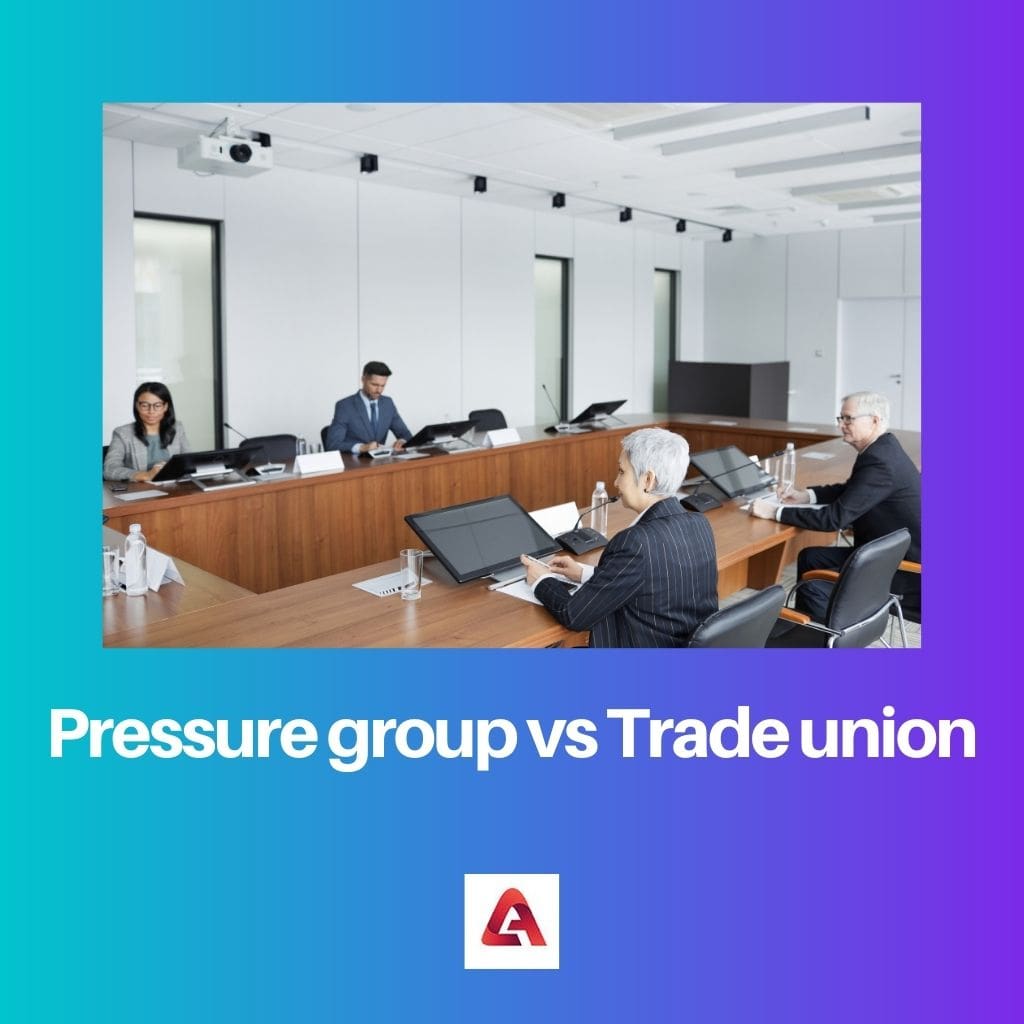Pressure Groups and Trade Unions are associations of people who work towards a particular goal or have some common intention.
Key Takeaways
- A pressure group is an organized group of individuals who share common interests and seek to influence public policy, legislation, or public opinion. At the same time, a trade union is an organization of workers who have joined together to protect their rights and interests in the workplace.
- Pressure groups can represent various interests, including environmental, social, and economic issues. At the same time, trade unions are primarily concerned with improving their members’ working conditions, wages, and job security.
- Both pressure groups and trade unions use various tactics, such as lobbying, public campaigns, and strikes, to achieve their goals. Still, their focus and membership differ based on the issues they address and the groups they represent.
Pressure Group vs. Trade Union
The difference between Pressure Groups and Trade Unions is that Pressure groups represent the dissenting views not expressed in mainstream statements and try to influence and change the socio-political structure. While Trade Unions tend to focus and only represent the members of a particular field of work and cater to their needs and demands.

Pressure groups are associations of people who organize and arrange themselves together to promote or defend their particular common interests.
Whereas members of a Trade Union are together because of the members working in the same organization or maybe because they have similar demands.
Comparison Table
| Parameter of Comparison | Pressure Groups | Trade Union |
|---|---|---|
| Meaning (Definition) | Pressure groups are organizations whose members share common attributes like interests and goals. | Trade Unions are organizations of people that represent a specific working class, especially in an industry or company. |
| Intention | They organize themselves to represent minority views and influence government policies and actions. | They are formed to protect an institution’s laborers or workers and put forward their demands as a whole. |
| Composition | They are formed by people who share a common idea or goal and could be from any walk of life. | They are formed by people working in the same sector; their occupation is the only binding factor. |
| Formation | Pressure groups come into existence due to increasing demands and scarcity of resources because of competition. | Trade Unions exist when an issue like employee exploitation or demand for more wages arises. |
| Scope | Pressure Groups have a wide area of work and represent various views from various fields that might pressure the political structure and lead to change. | The scope and area of Trade Unions are narrower, and they only tend to cater to the needs of wage earners and deal with issues like wages, working conditions, etc. |
What is Pressure Group?
Pressure groups are categories or sets of people who organize themselves to pursue a common interest or goal. Hence, they are widely also known as Interest Groups.
Pressure groups are only concerned with specific issues in the political structure, and their acts are related to promoting and protecting the views of their members by influencing government decisions.
Pressure groups have become essential to the democratic process as they act as communication or mediation links between the government and the people being governed, highlighting their views and demands.
Mainly Pressure groups use these three methods to make sure that their needs and interests are being put out to the public to be noticed. The methods extensively used are Electioneering, Propagandizing, and Lobbying.
There are majorly four different categories into which these pressure groups can be classified:
Associational Interest Groups:
These groups are formed with a common interest, but their organization lasts only until their goals are fulfilled, which is for a short period.
Institutional Interest Groups:
These groups are part of government machinery and consist of professional people. They try to put forward their views through legal means according to the rules and regulations.
Non-Associational Interest Groups:
These groups share a common interest because of some family or religious heads and are lineage or kinship groups. They are not organized and lack a formal structure.
Anomic Interest Groups:
These are groups of people who spontaneously or abruptly form a group and enter into the political structure creating riots, demonstrations, and similar activities to gain attention.

What is Trade Union?
Trade Unions are associations or organizations of workers or employees working in a particular company, industry, or institution. They are formed to improve their primary working conditions and protect their views and interests from exploitation.
Being organized as Trade Union gives more voice and power to the employees to defend themselves from being exploited as well as put forward and negotiate their demands.
There are various types of Trade Unions based on their composition. Broadly Trade Unions can be classified into three main categories:
Industrial Union:
These types of unions are formed by individuals working in the same industry. They could differ in their skills and duties, but they are together because they belong to the same industry.
Craft Union:
These unions are formed by individuals working on the same craft. They possess similar skills and are from the same occupation.
General Union:
These unions are open to all workers irrespective of the skill they possess or the field or industry they work in. Here there is no differentiation between workers.

Main Differences Between Pressure Group and Trade Union
- The main difference between Pressure Groups and Trade Unions is that Pressure Groups act as a link between the government and the people being governed by expressing minority views, while Trade Unions act as a link between employees and the employer by representing their needs and demands.
- The goal and scope of Pressure Groups are wide and towards the betterment of a large section of people, while Trade Unions target a selected and smaller section of people, i.e., the workers, and work for their betterment.


Understanding the varied categories of pressure groups and their role in influencing political structures is essential in comprehending their impact on society. The insights presented in the article are thought-provoking.
The categorization of pressure groups and their methods of influencing public opinion provide a clear understanding of their dynamic roles in shaping political decisions and advocating for diverse interests.
Indeed, it’s fascinating to examine the methods employed by pressure groups to assert their influence and impact decision-making processes.
Absolutely, the classification helps in appreciating the multifaceted approaches adopted by pressure groups to effect change.
The article effectively captures the essence of pressure groups and trade unions in advocating for justice and fairness. It highlights their integral roles in addressing socio-political issues and labor rights.
Trade Unions have played a vital role in ensuring the rights of workers are protected. The significance of these associations cannot be overstated.
Indeed, the impact of trade unions is profound, especially in advocating for fair working conditions and wages.
Absolutely, they are instrumental in safeguarding the labor force from exploitation and inequality.
These organizations are crucial in representing the interests of various groups and lead to positive changes in society. It’s important for people with common interests to unite and work towards their goals.
Absolutely, the influence of pressure groups and trade unions can shape the socio-political landscape for the better.
I agree, they are indeed crucial, and their roles should not be underestimated.
The detailed comparison provides valuable insights into the roles and functions of pressure groups and trade unions. It’s enlightening to understand their distinct purposes and impact.
The comparison between pressure groups and trade unions effectively illustrates their divergent purposes and memberships. It offers a comprehensive view of the distinct roles played by these associations in driving social and labor reforms.
Absolutely, the distinct characteristics and focuses of pressure groups and trade unions highlight their indispensable roles in advocating for diverse interests and addressing labor rights.
Indeed, the comparison emphasizes the unique contributions of pressure groups and trade unions in bringing about positive changes in society.
The in-depth analysis of pressure groups and trade unions provides valuable insights into their distinct compositions, intentions, and influences. It’s enlightening to understand the intricacies of these associations.
While trade unions focus on the protection of workers’ rights, pressure groups serve as influential channels to address broader societal issues. Both play an essential role in demanding change and justice.
Exactly, their roles complement each other in championing social and labor reforms.
Indeed, their distinct focuses contribute to a comprehensive effort in driving positive transformations in society.
The thorough explanation of trade unions sheds light on their pivotal role in advocating for the welfare of workers. Their formation and scope significantly contribute to a fair and just working environment.
Absolutely, the formation and intentions of trade unions underscore their commitment to protecting the labor force and ensuring equitable treatment in workplaces.